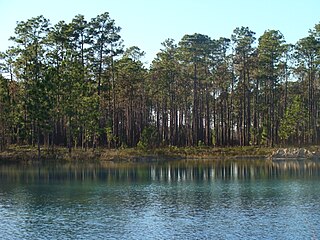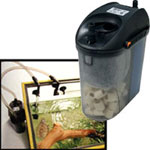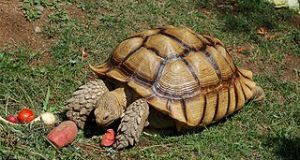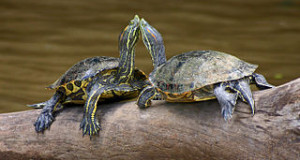All thirteen Map Turtle species are both fascinating and very attractive, with several being highly prized by reptile fans. Although best reserved for experienced keepers, Barbour’s Map Turtle (Graptemys barbouri) deserves more attention from both private enthusiasts and zoos. With a specialized diet and restricted range, it faces an uncertain future in the wild. I had the good fortune to work with Barbour’s Map Turtles at the Bronx Zoo, and would like to pass along some thoughts for those up to the challenge of keeping this spectacular creature.
Description
Female Barbour’s Map Turtles are very impressive, with noticeably-broad heads and shells that may approach 12 inches in length. The narrow-headed males are so much smaller – a mere 3.2 to 5.2 inches long – as to appear to be of a different species.
The carapace is brown to olive-green, with pale yellow or white marks along its edge, and is topped by 2 spine-like ridges. Yellow stripes decorate the neck and legs, and there are blotches of yellow behind the eyes.
Other Map Turtles, while smaller, exhibit a wide array of carapace “decorations”, colors and habits. You can read more about some of these in the articles linked below. Pictured here is the spectacular Ringed Map Turtle (G. oculifera).
Range and Habitat
The range of this USA endemic is restricted to the Apalachicola River System in the Florida Panhandle and Georgia.
Barbour’s Map Turtle is largely limited to clear, limestone-bottomed streams that contain numerous fallen branches and trees. Highly aquatic, it spends much time basking on logs, plunging into the water when disturbed. The Barbour’s Map Turtle feeds only in water, and, except when nesting, rarely travels far from shore.
The Aquarium
These large, active turtles require spacious homes. While a 55 gallon aquarium might suit a small male, females need tanks of 125 – 200 gallon capacity, or commercial turtle tubs and ponds.
Wading pools are often easier to manage than aquariums. Koi ponds sometimes contain shelves meant to hold plants; these work well as turtle basking areas. Outdoor housing is ideal, assuming that raccoons and other predators can be excluded.
Although highly aquatic, all map turtles need a dry surface on which to bask. Commercial turtle docks will suffice for small specimens. Cork bark, wedged or affixed via silicone to the aquarium’s sides, is a good option for adults.
Turtles are messy feeders and very hard on water quality. Submersible or canister filters are necessary unless the enclosure can be emptied and cleaned several times weekly (I’ve found the Zoo Med Turtle Clean Filter to be ideal). Even with filtration, partial water changes are essential.
Removing your turtles to an easily-cleaned container for feeding will lessen the filter’s workload and help to keep the water clean.
Substrate
Bare-bottomed aquariums are best, as gravel traps food and wastes, greatly complicating cleaning, and may be swallowed along with food.
Light and Heat
Heliothermic turtles (those that bask) require UVB radiation in captivity. If a florescent bulb is used (the Zoo Med 10.0 Bulb provides high UVB output), be sure that the turtle can bask within 6-12 inches of it. Mercury vapor bulbs broadcast UVB over greater distances, and also provide beneficial UVA radiation. Natural sunlight is the best UVB source, but be aware that glass filters-out UVB rays.
Water temperatures of 72-80 F should be maintained. An incandescent spotlight bulb should be used to warm the basking site to 90 F.
Companions
Barbour’s Map Turtles will eat or chase fishes, newts and aquatic frogs.
Females and juveniles may get along, but be prepared to house them separately as aggression often develops over time. Males often harass females with mating attempts, and may stress or bite them in the process; adult males cannot be kept together.
Feeding
In the wild, female Barbour’s Map Turtles feed almost entirely upon fresh water mussels, snails and crayfish. Males take smaller snails, insects, crayfish, and fish.
Pets should be offered a diet comprised largely of snails, crayfish, and mussels, along with whole fishes, earthworms and prawn. Those under my care accepted apple snails and other native and introduced species that I collected and bred, European land snails (introduced in NY, and also available in seafood markets), freshwater mussels and clams, periwinkles, crayfish, shiners, minnows, green crabs and fiddler crabs.
Goldfish should be used sparingly, if at all, as a steady goldfish diet has been linked to kidney and liver disorders in other turtle species. A high quality commercial turtle chow can comprise up to 30% of the diet. A cuttlebone should be available to supplement the calcium provided by whole fishes and similar foods.
Other important food items include earthworms, krill, freeze-dried river shrimp and, to a lesser extent, crickets and other insects.
Breeding
Field studies indicate that females take 20 or more years to reach breeding age. This fact, along with their small natural range and past over-collection for the pet trade, threatens the future of the Barbour’s Map Turtle. Reproduction has not been well-studied in the wild, but pets have produced 6-9 eggs in June and July.
Gravid females usually become restless and may refuse food. They should be removed to a large container (i.e. 5x the length and width of the turtle) provisioned with 6-8 inches of slightly moist soil and sand; please see article linked below). Gravid females that do not nest should be seen by a veterinarian as egg retention invariably leads to a fatal infection known as egg peritonitis. It is important to note that females may develop eggs even if unmated, and that captives may produce several clutches each year.
The eggs may be incubated in moist vermiculite at 82-86 F for 60-85 days. Please post below for further details concerning captive reproduction.
Temperament
These shy turtles adjust well to captivity if provided proper conditions, but they may not become as responsive as other map turtles. All turtles are capable of administering powerful bites and scratches when frightened, and must be handled with care.
Further Reading
Nesting Sites for Captive Turtles
Choosing the Best Turtle Filter
Slider, Map and Painted Turtle Care
 That Reptile Blog – Reptile, Amphibian and Exotic Pet Care and Information
That Reptile Blog – Reptile, Amphibian and Exotic Pet Care and Information







